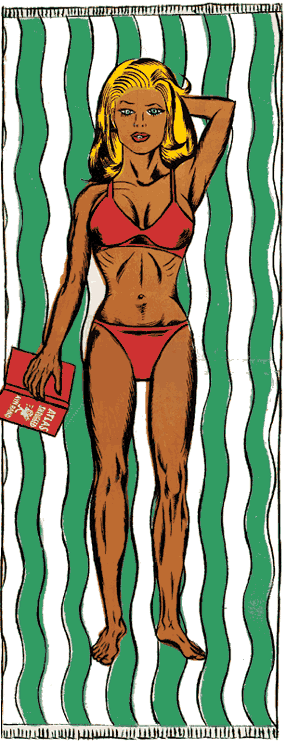The path leading to commercial eugenics will be paved with good inventions. Contemporary gene research focuses on admirable quests to cure diseases and defects, but how these advances will be applied may alter both our DNA and our definition of defect. For instance, in the ’80s, both Genentech and Eli Lilly received patents for a genetically engineered growth hormone intended to treat the more than 50,000 people with dwarfism in the U.S. Today, the hormone is one of the most frequently prescribed gene therapies available, and both firms have mounted an aggressive PR campaign to redefine normal shortness as an “illness.” Disease, it seems, is in the eye of the patent holder.
Cultural biases have often led to differences being labeled “defects,” and while we’ve come a long way since southpaws were burned at the stake, we want medicine to make us more than healthy; we want it to make us perfect. And when cosmetic medicine meets genetic manipulation, the results—for those who can afford them—could be far from superficial.
Color Me Nordic
She’ll be blond. Blond is the most popular hair dye in the U.S.; even kids show the same preferences: The flaxen-haired original Barbie outsells racially and ethnically diverse dolls. Eye color will suggest an equally chilly heritage (blue is the No. 1 colored contact lens color). She won’t need prescription contacts, and save for the occasional fashion accoutrement, specs won’t be necessary.
Structurally Sound
Her facial structure will probably conform to what anthropologists say the standard of beauty is for women in most cultures: large prominent eyes, wide cheekbones, big lips, and a tapered jawline. The male ideal, on the other hand, requires a square jaw and chin, and a powerful brow (think Superman).
On the Button
She’ll have a pert nose. Social critic Camille Paglia recently wrote that she hoped “the wonderful, strong, sharp nose of ‘The X-Files’ star Gillian Anderson will become a new plastic-surgery model for American girls, with their tedious Sandra Dee button-nose fetish.” Fat chance. Short and perky is still the choice among the 46,000 American women who had their noses bobbed in 1996.

All Men Are Created Equilateral
Her features will be balanced. The off-kilter angularity of supermodel Christy Turlington aside, research shows that those we find attractive have strong facial symmetry. True, parents-to-be are unlikely to be won over by the research that suggests that even-featured people have more sex partners. But expectant couples hardly need a doctor to tell them that attractive (i.e., symmetrical) people are more likely to earn more money and be better liked.
The Last Days of the Wonderbra
She’ll be well-endowed. With nearly 122,000 women a year getting breast implants, the market for an “all natural” bust can only grow. The Cambridge, Mass.-based company Reprogenesis plans to create whole breasts out of a woman’s own breast cells. Ostensibly, this will benefit women who undergo mastectomies (103,000 a year), but CEO James McNab told the Dallas Morning News he was hoping for a market closer to 250,000 a year.
The Other Hand
She may be ambidextrous. Some theorize that left-handed people have readier access to the creative side of their brain (note the artistry of such lefties as Presidents Reagan, Bush, and Clinton, as well as Leonardo da Vinci and Jim Carrey). But they’ve also been labeled “defective,” and they’ve been regularly punished by makers of school desks, airline seats, and scissors. Given the choice, will parents give their children an easy right or a hard left?
It’s as Easy as ABC
She’ll be smart. In 1996, Americans spent $40 billion on supplemental “consumer education,” proving that parents are already willing to shell out plenty in order to upgrade their own and their children’s aptitude. Who can doubt that they will seize the opportunity to enhance intelligence in utero?
The Belle Curve
She’ll be shapely. Gene cosmetologists may have to tailor their female-fashioning slightly for different markets, but an hourglass figure is universally admired. Based on studies of males from Africa, the Azores, Hong Kong, India, the Netherlands, and the U.S., psychologist Devendra Singh found that while the women men considered attractive might vary in size from Anna Nicole Smith to Twiggy, all had waists considerably narrower than their hips.
Legs Up to Here
She’ll have slender thighs. Only a plastic surgery lobby could bemoan the genetic elimination of most women’s “problem area.” Liposuction is the most widely performed cosmetic surgery procedure, with 149,000 people sucked and tucked in 1997.
Pretty Is as Pretty Does
She’ll be nice. Some research indicates that the genetic trait that makes people more impulsive might also make them more prone to commit violent crimes. Expectant parents might alter an embryo’s DNA in order to steer their kid straight. Staying straight is another story: Few dispute that homosexuality is at least partly inherited, but the tangle of factors that determine sexual orientation has most experts admitting that no single gene turns gayness “on.”











